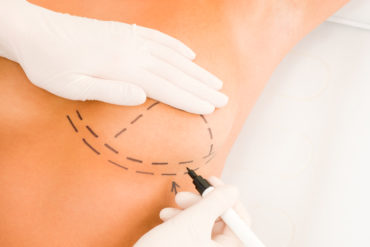If you’re deciding to undergo breast augmentation surgery, choosing between saline and silicone gels – two types of implants that have their own characteristics – is another step you’ll have to take.
Although you’ll have an opportunity to discuss these options in a consultation at your cosmetic surgery clinic, it helps to have an understanding of the implant types before deciding to meet with a surgeon and surgical consultant.
To help give you an idea about which type of implant is best for you and your body, we’ve put together short summaries of the surgeries.
Saline Breast Implants
Saline breast implants are silicone sacks that contain sterile salt water. They can be round or teardrop-shaped. The round implants help fill out the upper part of the breasts, whereas the teardrop implants create a more natural appearance.
Procedure: The cosmetic surgeon will make a small incision just beneath each breast fold or lower part of the areola, inserting a deflated silicone sack. The sacks are attached to tubes, which are then filled with salt water until they become the size you and the surgeon decided upon.
Cost: Prices vary from clinic to clinic, but you can generally expect to spend less on saline implants than silicone ones.
Risks: Although the incision is small, there’s a chance of the scar tissue hardening. This is called capsular contracture. The implants can also create ripples in the skin of each breast. If an implant ruptures, the salt water will escape. Your body will safely absorb it, but your breast will immediately lose its size and shape. You’ll have to return to your cosmetic surgeon to replace the deflated implant.
Unique Benefits:
- Saline breast implants leave a small scar that is hard to notice
- The implants can become almost any size because the surgeon inserts them before they’re enlarged
- By injecting more salt water into one implant, the procedure can correct minor breast asymmetry
Silicone Gel Breast Implants
These breast implants are completely silicone, made up of a sack that holds a gel. Like the saline option, silicone implants can be round or teardrops.
Procedure: Silicone breast implants require an incision on the lower portion of the areola or breast fold and must not exceed a certain size, as determined during consult. Unlike saline implants, silicone implants are completely intact, not deflated. The cosmetic surgeon will insert them, at their full size, under the tissue and underlying muscle.
Cost: Silicone implants typically cost more than a saline procedure, but many cosmetic surgery clinics offer financing plans.
Risks: Like saline, silicone implants can make breast skin appear rippled. The scar tissue can also harden and become noticeable. There was once a much talked-about theory that silicone caused breast cancer, but research has disproved this.
Unique Benefits:
- Although saline and silicone implants have the same risks, they’re less likely to occur with silicone
- The silicone gel will stay in place if the implant ruptures, keeping the breast’s appearance while only causing minor discomfort until you see your surgeon for a replacement
- Many patients say that silicone implants feel more natural than saline ones
Choosing between saline and silicone implants is a necessary part of deciding to undergo breast augmentation surgery. Use this information as a starting point, and learn more by talking to a surgical consultant and cosmetic surgeon.
>> The Brampton Cosmetic Surgery Center and Medical Spa has served the Greater Toronto Area (GTA) since 1994, and safely performs many breast augmentation procedures each year. Contact us today to learn more.
Like this post? Check out:
- Your Guide to Financing Cosmetic Surgery with Brampton Cosmetic - April 10, 2024
- Liposuction vs. Tummy Tuck: Which is Most Affective for Me? - March 21, 2024
- The Brampton Cosmetic Team Wishes You A Happy Holiday! - December 18, 2023
- Brampton Cosmetic’s Skincare & Beauty Holiday Gift Guide 2023 - November 22, 2023
- Microneedling & Beauty Booster Treatments to Target Some of The Most Difficult Skin Concerns - November 3, 2023






Comments are closed.